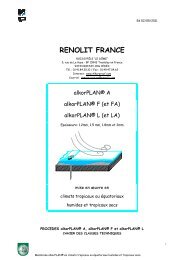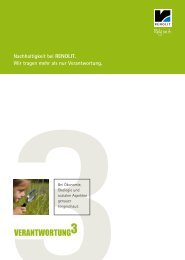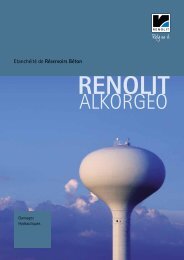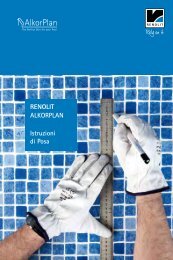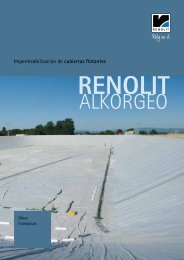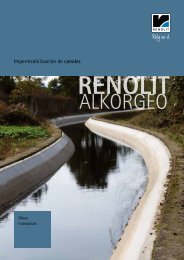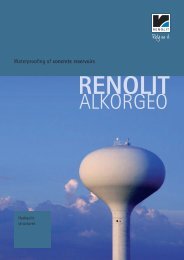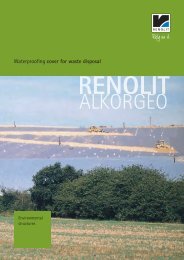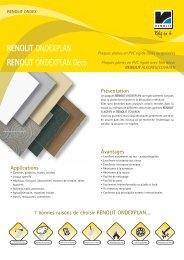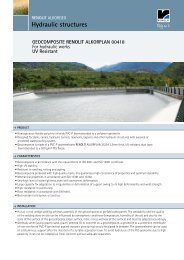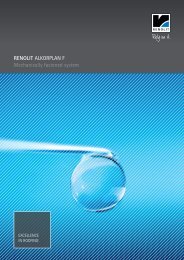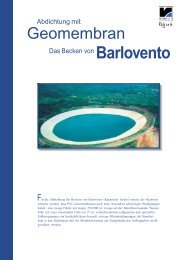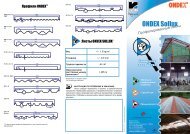RENOLIT EXOFOL_MX_Pflegehandbuch_englisch
RENOLIT EXOFOL_MX_Pflegehandbuch_englisch
RENOLIT EXOFOL_MX_Pflegehandbuch_englisch
You also want an ePaper? Increase the reach of your titles
YUMPU automatically turns print PDFs into web optimized ePapers that Google loves.
TECHNICAL INFORMATION<br />
INFORMATION REGARDING THE CARE AND REPAIR OF <strong>RENOLIT</strong> <strong>EXOFOL</strong> <strong>MX</strong> FILMS<br />
Contents Page<br />
General information 2<br />
Care 3<br />
Removing light soiling 3<br />
Abrasive cleaners 3<br />
Removing the residue of facade plaster 3<br />
Removing the residue of adhesives and sealants as well as paints 4<br />
Removing the residue of polyurethane foam 4<br />
Repair instructions<br />
Acrylate layer 5<br />
Mechanical damage 5<br />
Severe, large-scale damage 5<br />
Painting 5<br />
Manufacturer information<br />
Cleaning agents 6<br />
Protective films 7<br />
Repair kits 8<br />
Paints 8<br />
This technical information sheet reflects our current state of knowledge and is intended to provide non-binding information. The details contained<br />
herein do not release the users of our products from their obligation to carry out their own checks and tests which must ensure compliance with the<br />
appropriate national guidelines for the particular intended use. In particular, it is the responsibility of the purchaser to check whether the product<br />
purchased is suitable for the particular intended use.<br />
Date of issue 05/2010
GENERAL INFORMATION<br />
<strong>RENOLIT</strong> <strong>EXOFOL</strong> <strong>MX</strong> is a multi-layer film whose surface consists of a transparent layer of acrylate. This<br />
layer is compact, impervious and free from bubbles and pores. In addition, like a weather shield, it protects the<br />
dyed layers and, in the case of wood decors, the printed PVC layer lying beneath it from attack by sunlight and<br />
the weather. UV radiation, among other things, places a considerable burden on materials used in outdoor<br />
areas.<br />
The absorption, i.e. the reduction in the intensity, of the damaging ultraviolet (UV) light follows a physical law: if<br />
it were possible to cut the acrylate layer into thin slices, each layer would absorb the same proportion of<br />
radiation. The 50 µm thick acrylate film used on <strong>RENOLIT</strong> <strong>EXOFOL</strong> <strong>MX</strong> absorbs virtually 100% of the UV light.<br />
If the acrylate layer were only 20 µm thick, it would be able to absorb only around 90% of the UV radiation.<br />
In addition, the acrylate layer determines the surface properties of <strong>RENOLIT</strong> <strong>EXOFOL</strong> <strong>MX</strong>. The surface<br />
withstands mechanical stress in the same way as other plastics, e.g. the uPVC which is used for white plastic<br />
windows.<br />
Environmental influences such as acid rain do not attack the surface. However, the surface will virtually always<br />
be damaged by the effects of solvents. The surface can swell or even become detached. Only aliphatic<br />
benzines and highly diluted aqueous solutions of the alcohols ethyl alcohol and isopropyl alcohol do not attack<br />
the acrylate. A surface laminated using <strong>RENOLIT</strong> <strong>EXOFOL</strong> <strong>MX</strong> is extremely easy to care for and robust. In<br />
many cases, cleaning or work to repair damage is necessary only when the material is turned into windows or<br />
as a result of transportation and installation, mounting the windows, rendering and painting the building or<br />
renovation work.<br />
The simplest means of protecting the surface against soiling and mechanical damage is to mask it using a<br />
self-adhesive protective surface film. Manufacturers of plastic profiles do generally apply such a masking film<br />
to their profiles. However, this masking film serves only to protect the profiles against damage until they are<br />
delivered to the window manufacturer. It does not cover the entire surface and must therefore be<br />
supplemented on the window manufacturer’s premises. The profile is then protected until the window itself is<br />
mounted. Once the window has been installed, the functional life of the masking film is limited to a couple of<br />
weeks or months. If the protective film is exposed to the sunlight for excessive periods of time, the adhesive<br />
layer ages and adhesive residue may adhere to the window film when the protective film is removed. Either a<br />
building must be completed within this period or the protective film must be removed and carefully reapplied.<br />
Date of issue 05/2010
CARE<br />
The best way to care for window profiles coated with <strong>RENOLIT</strong> <strong>EXOFOL</strong> <strong>MX</strong> is to use water. If necessary, a<br />
standard cleaning agent can be added to the water or a glass cleaner for windows (without spirit) diluted with<br />
water can be used. Dirt is unable to settle on the smooth surface of the film which therefore can be removed<br />
very easily. No further care is necessary.<br />
REMOVING LIGHT SOILING<br />
The best way to remove light soiling such as dust, rain splashes, pencil marks etc. is to use water. However,<br />
greasy dirt such as fingerprints, lubricants, flies, fly droppings etc. can be removed easily, too. Aqueous<br />
solutions of standard household cleaners or cleaning agents developed specially for use on <strong>RENOLIT</strong> <strong>EXOFOL</strong><br />
<strong>MX</strong> should be used for this purpose. A list of these cleaning agents can be found in the appendix.<br />
ABRASIVE CLEANERS MUST NOT BE USED<br />
Always observe the instructions for use supplied with the cleaner. If you are unsure whether the cleaner is<br />
suitable, you should first test it on a concealed part of your window as a precautionary measure.<br />
REMOVING THE RESIDUE OF FACADE PLASTER<br />
The plaster materials generally used nowadays can be subdivided into two categories: mineral external plaster<br />
and resin plaster.<br />
Purely mineral external plasters can be removed from the surface using water and household cleaners<br />
although it should be borne in mind that the quartz sand contained in the plaster has a strongly abrasive effect.<br />
This leads to a thinning of the acrylate surface layer of the <strong>RENOLIT</strong> <strong>EXOFOL</strong> <strong>MX</strong> and consequently to a<br />
reduction in the weathering protection it offers. However, such plaster adheres in a purely mechanical manner.<br />
Resin plasters contain acrylates as binders which are chemically related to the acrylate layer of the film and<br />
are therefore capable of adhering strongly. Water with an added cleaning agent helps only if the plaster is still<br />
relatively fresh and has not dried completely. If the plaster has already dried, removing any residue will require<br />
a great deal of patience.<br />
Date of issue 05/2010
First of all, you should carefully remove the bulk of the remaining plaster mechanically. Water and a brush will<br />
then be helpful. Finally, the remaining plaster film can be washed off using an aliphatic benzine. Please note:<br />
the resin plaster also contains large-particle, highly abrasive mineral ingredients which can damage the<br />
surface and therefore the acrylate layer.<br />
For difficult, time-consuming cleaning work, a machine with a rotating brush may help. Please note: never use<br />
abrasive brushes and under no circumstances should you allow the brush to run dry. The friction will cause the<br />
acrylate layer to melt, destroying it in the process.<br />
REMOVING THE RESIDUE OF ADHESIVES AND SEALANTS AS WELL AS PAINTS<br />
The profile manufacturer glues the window film to the profile using special adhesives. Very rarely, adhesives<br />
can end up on the surface of the film and become dried on. This forms a very resilient layer although it does<br />
not adhere strongly. With a great deal of effort, the adhesive can be removed using aliphatic benzine. The<br />
residue of protective films can be removed using the recommended cleaning agent (see appendix). It is more<br />
difficult to remove the residue of sealants and paints. It is best to remove these before they have dried. It will<br />
be more difficult to remove them later on although it is still possible owing to their soft and elastic consistency.<br />
Heavy soiling must first be carefully removed mechanically and the rest using aliphatic benzine. Under normal<br />
circumstances, paints are not designed to adhere to the surface of the window. However, they frequently<br />
contain acrylates as light-stable binder components and adhere well to the chemically related acrylate surface<br />
of the window film.<br />
Aliphatic benzines can attack single-component paints and may even be able to dissolve them. However, in the<br />
case of cross-linked two-component paints, it is impossible to remove any paint residues.<br />
It is never easy to remove the residue of adhesives, sealants or paints, especially considering that there is a risk<br />
of causing additional mechanical damage.<br />
The best way to prevent such problems from occurring is to exercise extreme care when masking the profiles. It<br />
really is worth the effort!<br />
REMOVING THE RESIDUE OF POLYURETHANE FOAM<br />
The residue of polyurethane foam must always be carefully removed using aliphatic benzine before the foam<br />
has completely cured. Cured foam is completely insoluble, regardless of which solvent is used. It can then only<br />
be removed mechanically using a fine wooden spatula followed by steel wool (000). This will inevitably result<br />
in damage to the surface of the film and thinning of the protective acrylate layer. Do not use “miracle cleaners”<br />
which claim to be able to remove such residue. These are highly suitable for cleaning polyurethane-foam guns<br />
but dissolve everything apart from metal.<br />
Date of issue 05/2010
REPAIRING THE ACRYLATE LAYER<br />
The subsequent fixing of additional profiles to film-coated windows using adhesives containing solvents may<br />
lead to damage caused by blistering (if the adhesive joint is not allowed to dry sufficiently, the remaining solvent<br />
in the area surrounding the adhesion point can spread by diffusion and form blisters if heated to temperatures<br />
around its boiling point). Such damage can be fixed by cutting open the blister, carefully flattening the edges<br />
using a fine, sharp blade and restoring the protective acrylate layer using acrylic spray paint such as that<br />
available from the company König. Supplier details can be found in the appendix.<br />
REPAIRING MECHANICAL DAMAGE<br />
Damage to the film surface can occur when the profiles are handled or made into windows and when the<br />
windows are installed and subsequently used. Scratches and deep scores, hammer marks, impacts, edge<br />
damage, small holes drilled in the wrong place etc. are comparable to damage to furniture. The company<br />
Heinrich König & Co offers a complete range of products for repairing mechanical damage with the slogan<br />
“Everything for repairing and conserving wooden and plastic surfaces”. These products are well suited for use<br />
on <strong>RENOLIT</strong> <strong>EXOFOL</strong> <strong>MX</strong>. Instructions describing the individual steps in detail are provided. The company<br />
offers courses for specialists and interested workmen looking to gain the necessary knowledge and skills. The<br />
address can be found in the appendix.<br />
REPAIRING SEVERE, LARGE-SCALE DAMAGE<br />
Inappropriate treatment of the surface using unsuitable cleaning agents or solvents can cause severe, largescale<br />
damage. Such damage manifests itself in the greying and fading of the colour, the formation of cracks<br />
and the detachment of the acrylate layer or even the detachment of the <strong>RENOLIT</strong> <strong>EXOFOL</strong> <strong>MX</strong> film from the<br />
PVC profile if the film was attached badly. The range of products from König is suitable for repairing minor<br />
damage with an area of up to a few square centimetres. It is extremely difficult to repair larger areas.<br />
PAINTING<br />
Window profiles can be professionally painted by specialist companies. However, film-coated window profiles<br />
will require special types of paint. A so-called “second painting” makes it possible to alter the colour of the<br />
windows and therefore their visual appearance. In the event of damage, plain-coloured windows can be<br />
repaired by painting. The surfaces which are to be painted must first be prepared in an appropriate manner.<br />
Generally speaking, we recommend that the paining work be carried out only by specialist companies which<br />
have the necessary experience in this field.<br />
Date of issue 05/2010
TECHNICAL INFORMATION<br />
MANUFACTURERS OF CLEANING AGENTS FOR <strong>RENOLIT</strong> <strong>EXOFOL</strong> <strong>MX</strong><br />
Burnus GmbH<br />
Rößlerstr. 94<br />
64293 Darmstadt – Germany<br />
Phone: +49 (0) 6151-873 681<br />
Fax: +49 (0) 6151-873 801<br />
Fenoplast Fügetechnik GmbH<br />
Königszug<br />
35688 Dillenburg – Germany<br />
Phone: +49 (0) 2771-237 88<br />
Fax: +49 (0) 2771-5421<br />
Weiss Chemie & Technik GmbH & Co KG<br />
Hansastr. 2<br />
35708 Haiger – Germany<br />
Phone: +49 (0) 2773-815 0<br />
Fax: +49 (0) 2773-815 37<br />
Date of issue 05/2010<br />
Intensive plastic cleaner + conditioner Anti-static<br />
plastic cleaner<br />
www.burnus.com<br />
Fenosol 20<br />
www.fenoplast.de<br />
CHEMICAL RESISTANCE AND CARE OF <strong>RENOLIT</strong> <strong>EXOFOL</strong> <strong>MX</strong><br />
Cosmofen Color special cleaner Cosmofen 20<br />
www.weiss-chemie.com<br />
Resistant to standard household agents such as aqueous ammonia, aliphatic benzines, weak alcohol-water solutions,<br />
cleaning agents (non-abrasive), water and construction materials, e.g. cement, plaster.<br />
Sensitive to organic solvents, organic solvent mixtures and preparations containing organic solvents (e.g. paint thinner,<br />
paint remover, polishes, adhesives…).<br />
Thorough cleaning with standard cleaning agents (except abrasive cleaners) is sufficient in order to care for the film.<br />
This technical information sheet reflects our current state of knowledge and is intended to provide non-binding information. The details contained<br />
herein do not release the users of our products from their obligation to carry out their own checks and tests which must ensure compliance with the<br />
appropriate national guidelines for the particular intended use. In particular, it is the responsibility of the purchaser to check whether the product<br />
purchased is suitable for the particular intended use.
TECHNICAL INFORMATION<br />
MANUFACTURERS OF <strong>RENOLIT</strong> <strong>EXOFOL</strong> <strong>MX</strong> PROTECTIVE FILMS<br />
Bischof & Klein GmbH<br />
Rahestr. 47<br />
D - 49525 Lengerich<br />
Tel.: +49 (0) 5481 / 920 – 300<br />
Fax: +49 (0) 5481 / 920 – 98 300<br />
www.bischof-und-klein.de<br />
CTS Folien Service GmbH<br />
An der Autobahn 5<br />
D - 68789 St.-Leon Rot<br />
Tel.: +49 (0) 6227 / 88 18 65<br />
Fax: +49 (0) 6227 / 88 18 64<br />
www.ctsfolien.de<br />
Nitto Deutschland GmbH<br />
Dr.-Detlev-Carsten-Rohwedder-Str. 7<br />
D - 47228 Duisburg<br />
Tel.: +49 (0) 2065 / 836 – 0<br />
+49 (0) 40 / 63707703<br />
Fax: +49 (0) 2065 / 836 -136<br />
www.nitto.com<br />
Novacel GmbH<br />
Normandiestr. 3<br />
D - 50259 Pulheim<br />
Tel.: +49 (0) 2234 / 9874 – 0<br />
Fax: +49 (0) 2234 / 9874 – 75<br />
www.novacel.de<br />
Poli - Film GmbH<br />
Alte Papiermühle Hämmern 10<br />
D - 51688 Wipperfürth<br />
Tel.: +49 (0) 2267 / 697 - 0<br />
Fax: +49 (0) 2267 / 697 – 112<br />
www.poli-film.de<br />
T = transparent; F = pigmented<br />
Date of issue 05/2010<br />
Embossing 083, 148, 167 und 195:<br />
SK 547 AT-UV (T)<br />
SK 65950 KLN (F)<br />
Embossing 048:<br />
SK 548 AT-UV (T)<br />
SK 659100 KLN (F)<br />
Embossing 083, 148, 167 und 195:<br />
SK 547 AT-UV (T)<br />
SK 65950 KLN (F)<br />
Embossing 048:<br />
SK 548 AT-UV (T)<br />
SK 659100 KLN (F)<br />
Embossing 048:<br />
3104H5 (F)<br />
Embossing 083, 195:<br />
30804 (F), 3104H5 (F)<br />
Embossing 148:<br />
4075 (T), 30804 (F), 3104H5 (F)<br />
Embossing 167:<br />
4058R7 (T), 4075 (T), 30804 (F), 3104H5 (F)<br />
Embossing 083, 148, 167 und 195:<br />
9380 (F)<br />
Embossing 048:<br />
4324 (T)<br />
PF 12, PF 12/3,<br />
PF 562 C/80,<br />
PF 563 C/80<br />
The producers of protective films recommend preliminary tests regarding adhesion and processing of the films in any<br />
case.<br />
This listing of producers has no ranking without any classification of the quality. It should only give a recommendation. There also can be other<br />
producers offering suitable products. This technical information sheet reflects our current state of knowledge and is intended to provide non-binding<br />
information. The details contained herein do not release the users of our products from their obligation to carry out their own checks and tests which<br />
must ensure compliance with the appropriate national guidelines for the particular intended use. In particular, it is the responsibility of the purchaser to<br />
check whether the product purchased is suitable for the particular intended use.
TECHNICAL INFORMATION<br />
PAINTS AND REPAIR KITS FOR <strong>RENOLIT</strong> <strong>EXOFOL</strong> <strong>MX</strong><br />
Manufacturers of repair kits<br />
Heinrich König & Co. Clear lacquer Plus 345<br />
An der Rosenhelle 5 (silk gloss, Acryl-Lack Pro Silikon)<br />
D - 61138 Niederdorfelden<br />
Tel.: +49 (0) 6101 / 5360 – 0<br />
Fax: +49 (0) 6101 / 5360 – 11 www.heinrich-koenig.de<br />
Manufacturers of paints<br />
Feyco AG Alpocryl HR (Heat resistant)<br />
Industriestr. 11<br />
CH-9430 St. Margrethen<br />
Tel.: +41 (0) 71 / 7 47 84 11<br />
Fax: +41 (0) 71 / 7 47 85 10 www.feyco.ch<br />
Harzlack Ltd. Panadur 2K Industrial coating for PVC-R<br />
Am Sülzegraben 17 with related hardener, thinner and anti-foaming agent<br />
D - 38820 Halberstadt<br />
Tel.: +49 (0) 39 41 / 62 40 10<br />
Fax: +49 (0) 39 41 / 62 40 20 www.harzlack.de<br />
Akzo Nobel Deco GmbH Rubbol BL Satin<br />
Wernher-von-Siemens-Straße 11 grounding: Redox BL oder Redox AC<br />
D - 31515 Wunstorf<br />
Tel.: +49 (0) 50 31 / 961 - 289<br />
Fax: +49 (0) 50 31 / 961 – 333 www.anfh.de<br />
This technical information sheet reflects our current state of knowledge and is intended to provide non-binding information. The details contained<br />
herein do not release the users of our products from their obligation to carry out their own checks and tests which must ensure compliance with the<br />
appropriate national guidelines for the particular intended use. In particular, it is the responsibility of the purchaser to check whether the product<br />
purchased is suitable for the particular intended use.<br />
Date of issue 05/2010



